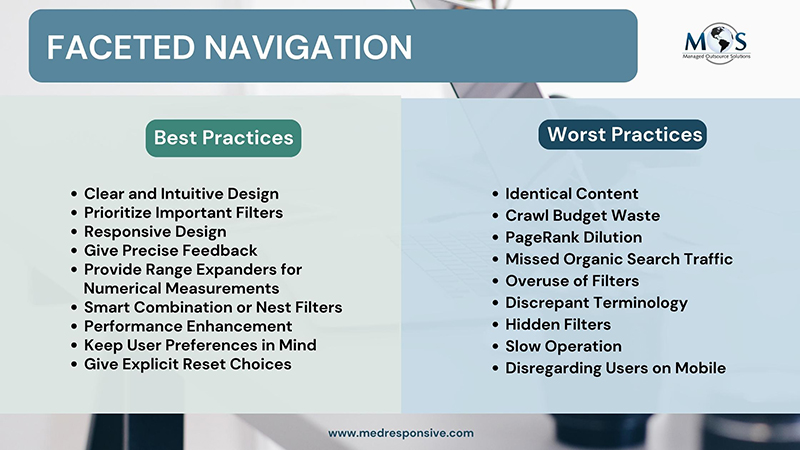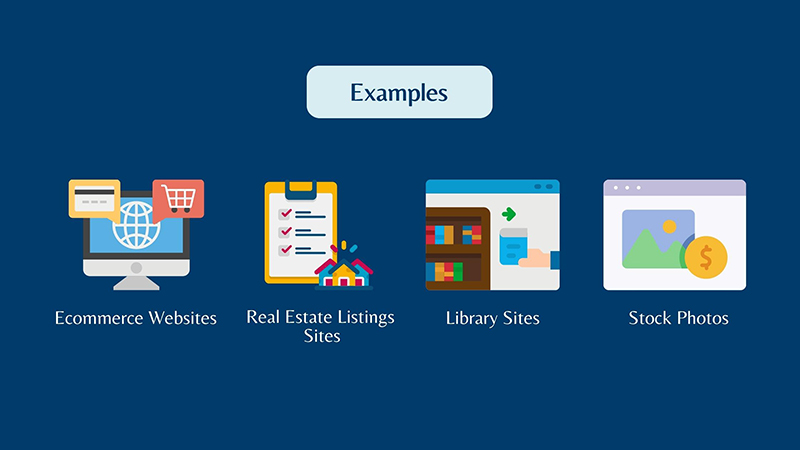Uncover the secret behind optimizing user experience with faceted navigation on your website – a game changer for engagement!

Image courtesy of via DALL-E 3
Table of Contents
Introduction to Faceted Navigation
Have you ever shopped online and used search filters to quickly find the perfect product you were looking for? That’s exactly what faceted navigation is all about! In this section, we’ll explore what faceted navigation is and why it’s so important, especially when shopping online.
What is Faceted Navigation?
Faceted navigation is like having a magic wand that helps you find exactly what you need in a sea of products. It works by using search filters and menus that allow you to narrow down your choices quickly and efficiently. Imagine having the power to choose the color, size, price range, and more for the product you want, all with just a few clicks!
Why It Matters
Faceted navigation is a game-changer when it comes to saving time and energy while shopping online. Instead of scrolling through endless pages of products, you can easily refine your search and find exactly what you’re looking for in no time. It’s like having a personal shopping assistant right at your fingertips!
How Faceted Navigation Works
Faceted navigation works by using filters to help users narrow down their choices. Filters are like categories that allow you to select specific options to refine your search. For example, when shopping online, filters can include options like size, color, brand, price range, and more. By choosing these filters, you can see only the products that match your preferences, making it easier to find what you are looking for.
Sorting Results
In addition to filters, faceted navigation also allows users to sort their search results. Sorting helps arrange items based on certain criteria, such as best match, lowest price, newest arrivals, highest customer ratings, and more. This feature is handy when you have a general idea of what you want but want to view the options in a specific order. By sorting the results, you can quickly find the product that best suits your needs.
Benefits of Faceted Navigation
Faceted navigation offers several advantages when shopping online. Let’s explore some of the key benefits that make it a valuable tool for users.

Image courtesy of www.seoclarity.net via Google Images
Find Products Quickly
One of the biggest benefits of faceted navigation is the ability to find products quickly. By using search filters like size, color, brand, and price range, shoppers can easily narrow down their options and locate exactly what they are looking for without having to sift through numerous irrelevant items. This saves time and makes the shopping experience more efficient and enjoyable.
Customize Your Search
Faceted navigation also provides users with the flexibility to customize their search based on their specific preferences and requirements. Whether someone is looking for a specific brand, a particular size, or a product within a certain price range, they can easily tailor their search by selecting the relevant filters. This level of customization ensures that shoppers can find products that align with their individual needs and preferences.
Examples of Faceted Navigation
One popular example of faceted navigation can be seen on online shopping platforms like Amazon. When you search for a product on Amazon, you will notice a variety of filters on the left-hand side of the page. These filters allow you to narrow down your search by selecting options such as brand, price range, size, color, and more. By using these filters, you can quickly find the exact product you are looking for without having to sift through irrelevant items.
Libraries and Databases
Faceted navigation is not limited to online stores; libraries and databases also make use of this feature. When searching for a book in a library catalog or academic articles in a database, you can apply filters to refine your search results. These filters may include options to sort by publication date, author, subject matter, and more. By using faceted navigation in libraries and databases, users can efficiently locate the information they need and streamline their research process.
Challenges with Faceted Navigation
One of the challenges with faceted navigation is the possibility of having too many filters to choose from. Imagine going to an online store and seeing a long list of options like color, size, brand, price range, and more. Sometimes, having so many choices can be overwhelming and confusing for users, especially if they are unsure about what they are looking for. It can result in decision fatigue, where the user becomes tired of deciding and might end up leaving the website without making a purchase.

Image courtesy of www.medresponsive.com via Google Images
Technical Problems
Another issue that users might encounter with faceted navigation is technical problems on the website itself. Sometimes, the filters may not work correctly or the website may experience glitches that prevent users from properly using the search filters. This can be frustrating for users who are trying to narrow down their search results to find the exact product they are looking for. Technical issues can disrupt the user experience and deter people from using the website in the future.
Tips for Using Faceted Navigation
When using faceted navigation on online shopping websites, it’s important to keep a few things in mind to make your search experience smooth and efficient. Here are some handy tips to help you navigate and find what you need quickly:
Start Broad, Then Narrow Down
Begin your search with a general category or keyword to get a wide range of results. Once you have a list of products, use the filters to refine your search further. This way, you can gradually narrow down your options to find exactly what you’re looking for.
Know What You Want
Before diving into the filters, take a moment to think about the specific features or characteristics you are searching for in a product. Whether it’s the color, size, price range, or any other specifications, having a clear idea of what you want will help you use the filters effectively to find the perfect match.
Future of Faceted Navigation
In the future, faceted navigation is likely to become even more advanced with the integration of Artificial Intelligence (AI) and Machine Learning technologies. These technologies can make search filters smarter and more helpful by learning from user behavior and preferences. Imagine a shopping experience where the website suggests filters based on your past searches and purchases, making it quicker and easier to find exactly what you’re looking for.

Image courtesy of www.medresponsive.com via Google Images
Voice Search
Another exciting development in the future of faceted navigation is the rise of voice search. Instead of typing in filters and categories, users might be able to simply speak aloud what they are looking for, and the website will navigate and filter results accordingly. This hands-free approach to navigation could revolutionize the way we search for products online, making it even more convenient and user-friendly.
Summarizing Key Points
In this blog post, we explored the concept of faceted navigation, which is a helpful tool commonly used in online shopping to quickly find products. Faceted navigation works by allowing users to use search filters and menus to refine their search results based on specific criteria such as size, color, price, and more.
One of the key benefits of faceted navigation is the ability to save time and find exactly what we need by customizing our search based on personal preferences. By starting with a broad search and then narrowing down the results using filters, users can efficiently navigate through a vast amount of products and information.
Examples of websites that effectively use faceted navigation include popular online stores like Amazon, as well as libraries and databases that allow users to search using similar filtering options. However, there are challenges that can arise with faceted navigation, such as too many filters overwhelming users or technical problems that may hinder the user experience.
As we look to the future of faceted navigation, advancements in AI and machine learning may make search filters even smarter and more helpful. Additionally, voice search technology could revolutionize how we navigate and search for items online, providing a more user-friendly experience.
Want to turn these SEO insights into real results? Seorocket is an all-in-one AI SEO solution that uses the power of AI to analyze your competition and craft high-ranking content.
Seorocket offers a suite of powerful tools, including a Keyword Researcher to find the most profitable keywords, an AI Writer to generate unique and Google-friendly content, and an Automatic Publisher to schedule and publish your content directly to your website. Plus, you’ll get real-time performance tracking so you can see exactly what’s working and make adjustments as needed.
Stop just reading about SEO – take action with Seorocket and skyrocket your search rankings today. Sign up for a free trial and see the difference Seorocket can make for your website!
Frequently Asked Questions (FAQs)
Common Queries
What are the most common filters?
Common filters typically include options like size, color, price range, brand, and customer ratings. These filters help you narrow down your search results to find exactly what you’re looking for.
Can all websites use faceted navigation?
While many websites, especially online stores, use faceted navigation to enhance the user experience, not all websites may have this feature. Websites that have a large inventory of products or information to search through usually benefit the most from implementing faceted navigation to help users find what they need quickly and efficiently.







